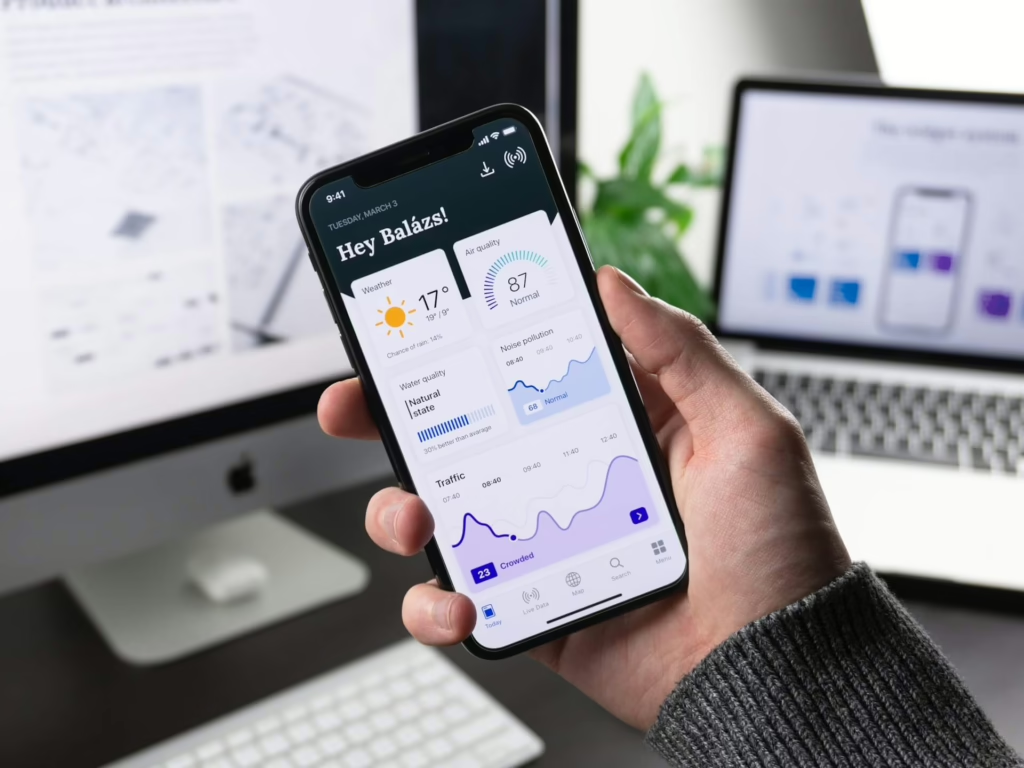In today’s world, we’re surrounded by apps that handle massive amounts of data. From healthcare to finance, e-commerce to real-time tracking, data intensive apps are becoming more and more essential.
But here’s the catch: these apps don’t just need to process tons of data—they need to do it in a way that’s intuitive and user-friendly.
So how do you design these kinds of applications without overwhelming your users? Well, that’s exactly what we’ll explore in this guide.
In this blog, we’ll explore the best practices, tips and strategies for designing data-intensive apps that are both efficient and user-friendly. If you’re an experienced UI/UX designer or just starting to work with data-heavy apps, this guide will give you everything you need to create seamless experiences for users.
What Are Data-Intensive Applications?
These are apps that handle large volumes of data, often in real-time. They can include everything from social media platforms to financial trading apps, healthcare monitoring systems, and even weather apps that track live updates.
The challenge? You’ve got all this data flying around, and you need to present it in a way that’s easy to understand and interact with, without bogging down performance or overwhelming the user. It’s a tricky balance, but with the right approach, it’s totally doable.

Challenges in Designing Data-Intensive Applications
When designing data-heavy apps, there are a few common challenges to watch out for. Let’s break down the major ones:
1. The Complexity of Data
Data-intensive apps often work with vast and varied datasets. Whether it’s user data, real-time information, or even complex datasets like medical records, this data needs to be presented in a way that doesn’t confuse the user. A simple UI/UX design is key to avoiding overwhelming your audience.
2. Performance and Load Time
With large datasets, performance can take a hit. Data-heavy apps can sometimes suffer from slow load times, which is a big no-no in the world of UI/UX design. Users expect apps to respond quickly, so optimizing performance should always be at the top of your priority list.
3. Real-Time Data Updates
For apps that rely on real-time data, such as stock trading apps or live event tracking, the UI/UX needs to handle constant updates without causing interruptions or disorientation. You don’t want your users to get lost in a sea of numbers or charts that keep shifting.
4. Scalability
As the amount of data grows, so does the complexity of managing it. If you design a data-heavy app without thinking about scalability, you risk performance issues down the line. A good design will accommodate future data growth without sacrificing usability.

Key Principles for Designing Data-Intensive Applications
Now that we’ve covered the challenges, let’s look at some core principles to follow when designing data-heavy apps.
1. Simplicity in User Interface
When dealing with massive amounts of data, the key is simplicity. Try not to cram too much information into one screen. Use design elements like cards, grids, and collapsible sections to break up data into digestible chunks. Also always keep the user’s goals in mind. What are they trying to accomplish? Make sure the design allows them to achieve that without distraction.
Also read: The Power of Invisible UI | Designing Without Distraction
2. Prioritizing Performance in UI/UX Design
Performance is crucial in data-intensive apps. Slow response times can frustrate users and drive them away. To optimize performance, try the following:
- Lazy Loading: Load data as needed rather than all at once.
- Efficient Data Queries: Use optimized queries to fetch only the data that’s necessary at any given time.
- Minimalist Design: Keep the design clean and uncluttered to allow for faster load times.
3. Effective Data Visualization
The data may be complex, but the way you visualize it shouldn’t be. Make sure to use clear and straightforward visualizations like bar charts, line graphs, and pie charts to represent the data. Keep it simple—avoid overwhelming the user with too many visual elements at once. For example, color-coding data and using interactive charts can help users engage without feeling lost.

UI/UX Strategies for Real-Time Data in Applications
Real-time data is one of the trickiest things to design for. Whether it’s sports scores or stock prices, you need to make sure your users are always up-to-date, without constantly refreshing the page. Here are some strategies to help:
1. Responsive User Interfaces
Real-time data means frequent updates, and it’s easy for a user to get confused if the interface keeps changing. Keep the user interface simple and responsive, so that the user’s experience doesn’t feel jarring when new data comes in. For example, you can use subtle animations to show data updates or implement auto-refresh functions.
2. User Feedback and Notifications
Real-time data can sometimes cause confusion if users aren’t sure if the data is accurate or if an update has occurred. To address this, use visual feedback such as a small spinning icon or a “last updated” timestamp. When appropriate, use notifications to alert users to important updates or changes.
3. Handling Data Latency
Data latency can sometimes occur when a server takes a bit longer to send updates. If this happens, make sure the user is aware. Display an icon or message saying “waiting for data” or “reconnecting.” This transparency builds trust and helps users stay calm when the data is temporarily unavailable.
Also read: The Ultimate Guide to Landing Page Design for 2025
Designing for Data Security and Privacy
Data-intensive apps often handle sensitive information, so security is a top priority. A good design doesn’t just protect data—it also builds trust with users.
1. Building Trust Through Design
To help users feel secure in your app, display clear privacy policies and give them control over their data. For example, include opt-in permissions for sharing data or encrypting information. A transparent approach to security will encourage users to feel safe using your app.
2. UI for Authentication & Authorization
A user-friendly login and authentication system is crucial for any app handling sensitive data. Use simple and intuitive authentication methods such as biometric logins or two-factor authentication (2FA). Ensure the design flow for account creation and login is seamless.
Also read: Using UX to Improve Cybersecurity: The Key Part of Design
Best Practices for Data Handling and User Experience
Now that we’ve discussed the core principles, let’s dive into a few best practices to ensure your app handles data efficiently and offers a positive user experience.
1. Data Preprocessing and Filtering
When presenting data to users, don’t overwhelm them with everything at once. Preprocess the data to display only what’s relevant. Use filters that let users drill down into the information they care about. A good filtering system will allow users to interact with the data in a meaningful way.
2. Pagination vs. Infinite Scrolling
Both pagination and infinite scrolling are popular for displaying large amounts of data, but which one is right for your app? It depends on the context. Pagination is ideal when you need to display a set number of items per page (e.g., 20 search results). Infinite scrolling works well for live updates or data that users might want to scroll through endlessly (e.g., social media feeds).
3. Search and Filtering Mechanisms
Search bars and filtering options are essential for data-heavy apps. Make sure the search function is easy to use, and don’t forget about advanced filtering options for users who want to dive deeper into specific data sets.
Examples of Data-Intensive App Design
Let’s take a look at a few real-world examples of data-heavy apps and how they successfully use design to handle complex data.
1. Healthcare App for Real-Time Patient Monitoring
In healthcare, apps like patient monitoring systems need to display complex data in an easily digestible way. A good example is using large, clear numbers for vital stats and color-coded visualizations for different health conditions. The design needs to balance data complexity with simplicity to avoid overwhelming doctors or caregivers.
2. E-Commerce App with Data-Driven Recommendations
E-commerce apps rely heavily on user data to drive recommendations. A good example is when apps display recommended products based on browsing history or past purchases. Clear product images, concise descriptions, and well-organized categories help users navigate the recommendations without feeling bogged down by data.
3. Financial App for Real-Time Market Data
Stock trading apps handle vast amounts of real-time data. To avoid overwhelming the user, these apps use simple graphs, color-coded alerts, and interactive charts that allow users to make informed decisions quickly and easily.
Tools and Techniques for Designing Data-Intensive Apps
Now that you’ve got the design principles in mind, let’s talk about some tools and techniques that can help make the process smoother:
1. Prototyping Tools
Prototyping tools like Figma, Sketch, and Adobe XD are essential when designing data-intensive apps. These tools allow you to create wireframes, interactive prototypes, and user flows that showcase how the app will behave with large amounts of data.
2. Data Management Tools
Managing large datasets during the design phase is crucial. Tools like Airtable, Google Sheets, or even databases like Firebase can help you organize and present the data you’ll be using during the design process.
3. User Testing for Data-Intensive Apps
User testing is essential to ensure that your app’s design works for the people who will actually use it. Focus on testing how users interact with complex data, ensuring they can find what they need without confusion or frustration.
Mobile vs. Desktop: Designing for Different Screen Sizes
Data-heavy apps need to be designed differently for mobile and desktop. On mobile, you’ll need to account for smaller screens and touch-based interactions. For desktop, there’s more screen real estate to work with, but you still need to ensure performance isn’t compromised.
The Future of Data-Intensive App Design
The world of data is evolving rapidly, and so is the design of data-intensive apps. In the future, AI and machine learning will likely play an even bigger role in how data is presented and analyzed, making apps smarter and more intuitive.
Conclusion
Designing a data-intensive app is a challenge, but with the right principles and strategies, it’s entirely possible to create an intuitive, user-friendly experience.
Keep things simple, prioritize performance, and always keep your user’s needs at the forefront. If you follow these guidelines, you’ll be well on your way to designing data-heavy apps that users love.
Ready to take your design skills to the next level? Reach out to us at Hapy Design, and let’s build something amazing together.
